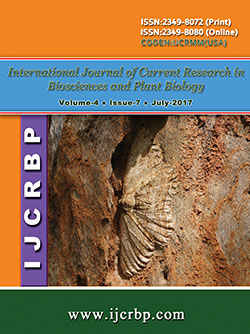 |
Online ISSN : 2349-8080 Issues : 12 per year Publisher : Excellent Publishers Email : editorinchiefijcrbp@gmail.com |
2Pharmacognosy Laboratory / Technical and Scientific Research Beninese Center, 01 BP 06 Oganla Porto-Novo/Benin
3Center for Computational and Integrative Biology, Rutgers, the State University of New Jersey 315 Penn Street, Science Building, Camden, NJ 08102-1411
The management of breeding sites is one of the preventive measures against malaria. However, in view of the environmental damage caused by the various chemical insecticides used for this purpose and especially the resistances developed by Anopheles gambiae (the main vector) with respect to these synthetic chemical compounds, we have proposed implementing of extracts plants. Thus, organic solvents with a gradient of polarities such as n-hexane, dichloromethane and methanol-water were used to extract the phytochemical compounds present in the leaves of Elaeis oleifera and Launaea taraxacifolia. The three different extracts obtained for each plant were tested on 3rd stage larvae from two genotypes of Anopheles gambiae: the Kisumu strain of Kenyan origin and the wild strain from the breeding sites of Cotonou. Phytochemical analysis revealed that in addition to tannins, flavonoids, anthocyanins, leuco-anthocyanins and triterpenes which are present in both plants, Elaeis oleifera also contains mucilages and alkaloids. The hydro-methanolic extracts were found to be the most active on the two origins of larvae with lethal concentrations LC50 of 448.01 ppm in 24 hrs and 51.38 ppm in 48 hrs of exposure for the Kisumu strain; 4199.63 ppm and 1456.44 ppm in 24 hrs and 48 hrs respectively for the wild population for Elaeis oleifera. In addition, Launaea taraxacifolia appeared much more interesting and displayed almost identical activities on the two larval origins with LC50 of 182.68 ppm and 135.13 ppm respectively in 24 hrs and 48 hrs for Kisumu larvae and 157.36 ppm in 24 hrs then 116.88 ppm in 48 hrs for wild larvae. It is therefore concluded that Launaea taraxacifolia can be used for bio-larvicide production in integrated malaria vector control.
